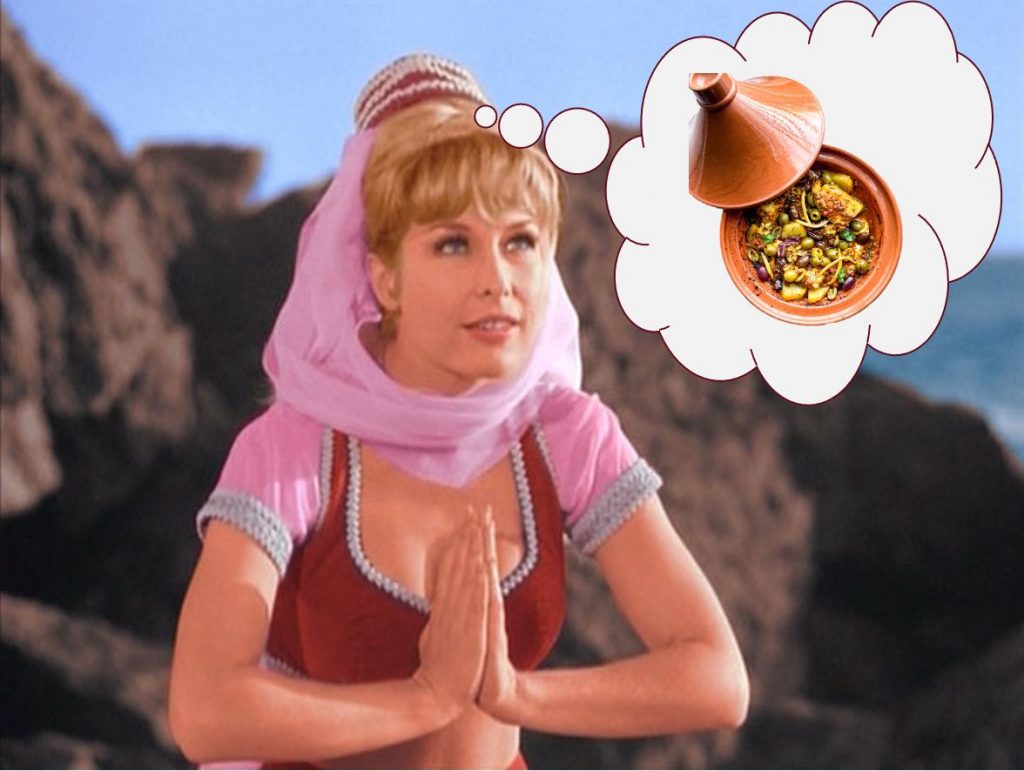
We managed to fit quite a bit of sight-seeing of Marrakech’s old city in just two days. We’ve just started our actual ‘guided tour’ on a big bus, left Kech an hour ago, and are starting to wind our way into the Atlas mountains. They are lovely, reddish, and covered in small shrubbery, but of course, also somewhat repetitive, so perhaps I’ll be able to get some writing done now.
Our hotel of the past 3 days, Maison Arabe, was – like many traditional muslim riads – unimpressive from the outside (with the exception of one Arabesque street-facing wall that contained the door to – of course – the hotel gift shop) but luxurious on the inside. In order to enter the hotel itself you have to walk up a small alley, where we met our first examples of, I think, what we all agreed was the number one annoyance of Marrakesh – the mopeds. We’re in an alley probably 7 feet wide and riders will tear up and down the streets at 20 miles an hour, which seems slow when you’re driving on an actual road, but sure doesn’t when you’re leaping out of the way of an angry buzzing vehicle. This blog post could also be titled “I nightmare of approaching 2-stroke engine sound”
The street cat situation we saw in Essaouira was, of course, also present here. In that same small moped-filled alley an orange and white long-haired mama cat and her two kittens lived. Being exposed to luxury hotel tourists on a constant basis, Mamacat was extremely friendly, happy to come up to anyone, trilling sweetly, to rub up against legs in the hopes of snackums being provided. It seemed that the nearby residents were helping her out; an old man brought a dish to her filled with what looked like a puree of tuna or chicken, which she and her larger kitten happily gobbled down. A box with a hole cut into it, with a towel inside, was placed against the alley wall, safe from mopeds between two of the hotel’s large planter pots.
We all thought – except my veterinarian mother – that the two kittens were from different litters. One was a white-and-tabby bicolor almost as large as Mamacat and seemed strong and outgoing. The other was a tiny orange kitten, even smaller than Riba when we got her in Panama, who seemed to perversely enjoy sitting in the middle of the alley, sunning himself. “I think they’re littermates, and that’s the runt, ” said mom, a bit sadly. The kitten responded sweetly to pets and gentle scritches, squeaking weakly and gazing blearily up at us. Mamacat seemed not entirely trained in Mamahood, nursing her orange kitten but then jumping up and running over to tourists for pettings and snacks at the slightest provocation. Even on the second day of our stay, my dad mused that the little orange baby might not make it, as he seemed weaker and less outgoing compared to the first day. However, I ordered the kitten not to die while we were staying at the hotel, as it would make us sad, and I’m happy to report that he obeyed my command, and this morning ate several cat treats out of the bag that I had purchased for Betsy (at her request) to carry around and give to every cat she saw. Let’s all wish him luck, shall we?
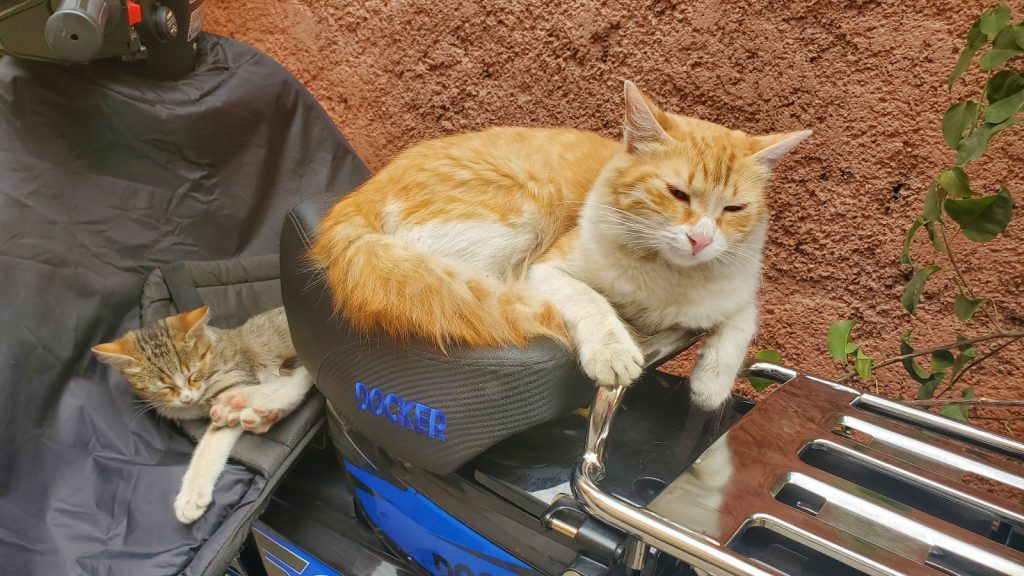
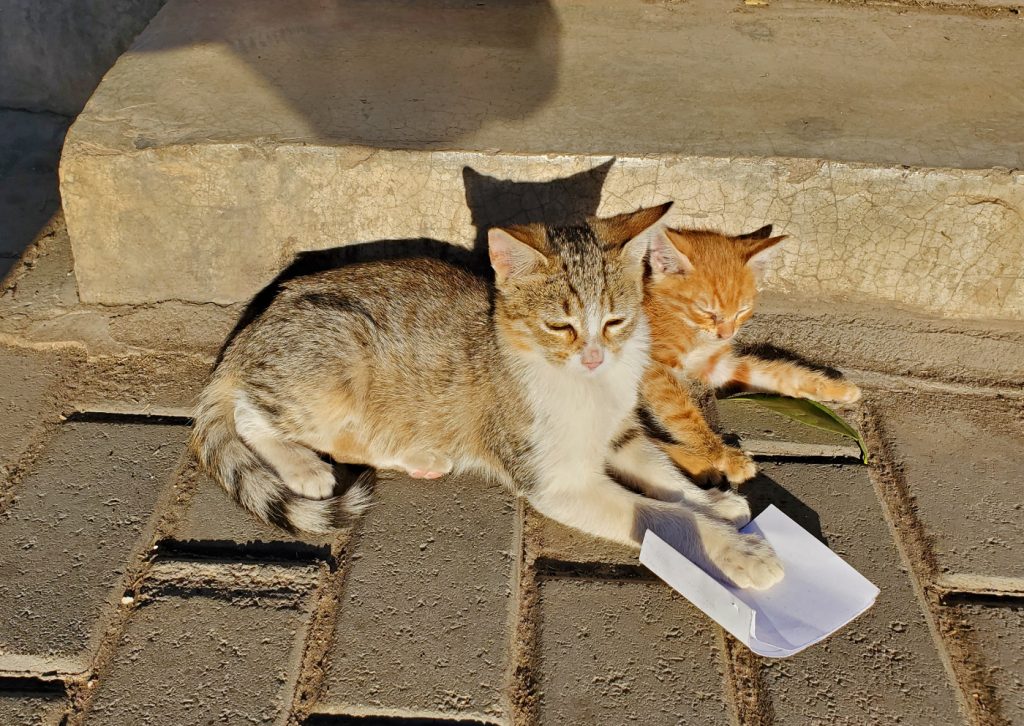
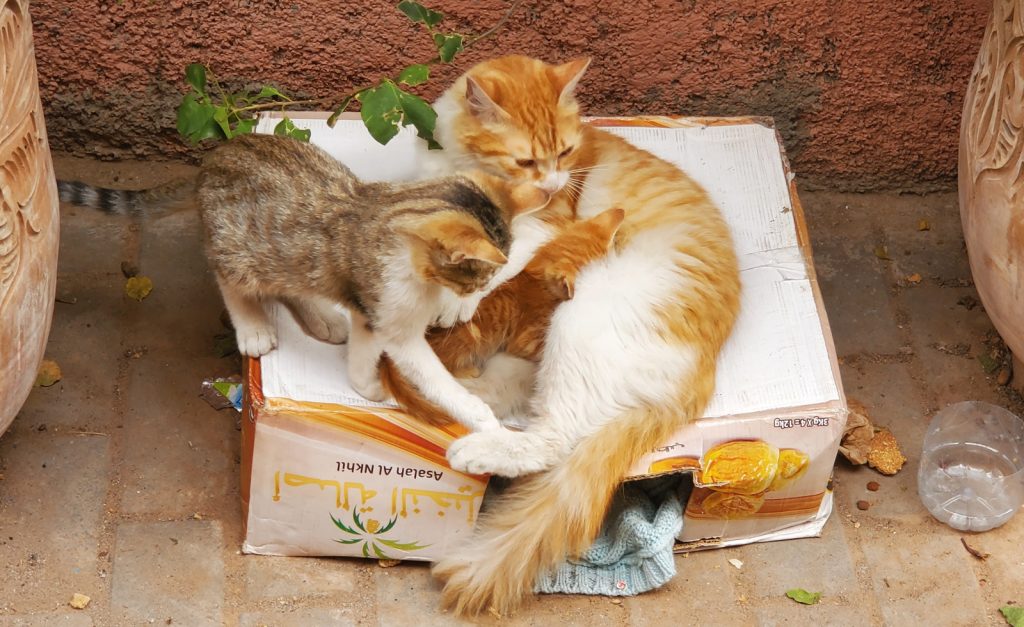
The hotel itself was a tightly twisting maze of numerous individual properties and buildings that had been slowly purchased and built up over decades, walls knocked down and connected together. If you were to view it isometrically I’m sure it would be like an Escher, or Dr Seuss drawing. Jazz bar with a pianist every evening, two restaurants, free tea every afternoon, hammam/massage, that sort of thing. A team of smiling young staff nodding at your slightest request. Whatever the heck the purpose of a nightly “turn down service” is. You get the picture. I’m sure some people love that sort of thing, but I preferred the much more authentic feeling beauty and rustiscm of the previous Riad Chbanate where we were left alone a little more and had more space. Maison Arabe didn’t even have exterior-facing windows for my parents or my “standard” rooms, just windows that faced back into the ceilinged ‘courtyards’ of the hotel itself. Betsy in a ‘junior’ suite had two small exterior facing windows (each about 6×12 inches in size) and after Connie and Nicole checked in, a couple hours after us fresh from the airport, they had a ‘deluxe’ suite with a balcony overlooking a non-ceilinged courtyard that incoming guests were served their introductory tea in. A nice place to be sure, and very nice staff, just not really my thing.
We had two days for sightseeing, so we scheduled the morning of the first day to see a couple nearby modern attractions, the afternoon for a guided tour, and the second day to explore entirely on our own. The hotel frequently employed the services of a small, easy-going Berber man also named Rachid as a driver for its guests, and we’d be seeing quite a lot of him over the next couple days. He told us that he and his family were also from the Atlas mountains just an hour from the city and their ancestral home had been destroyed by October’s earthquake – but thankfully, they all got out in time and no one was injured. Needless to say, he was tipped generously by our group.
The first two stops were next to each other – Majorelle Gardens, and Yves Saint Laurent’s Museum. Apparently the latter had been a French clothes designer or some such, pretty popular, made women’s clothes from the 60’s to early 2000’s. His museum was small with just a couple of exhibits – Australian Aboriginal snake art in one as the traveling/rotating piece, and a permanent collection of hundreds of YSL’s sketches where his dresses, both somewhat normal looking and bizarrely weird, bubbled out of his mind. Some of the actual dresses were on display too. There are only two YSL museums, one in Paris and one here, but apparently he and his companion Pierre bought a maison in what became the Majorelle Gardens and over the second half of his life, he’d spend many months of the year in Marrakech, sketching his imagination. The gift shop was credit card only, even for my 10 dirham (about 90 US cent) postcard. I’m guessing that the Museum/shop was entirely an extension of the European versions of the same, and wanted as little hard currency to deal with as possible.
The garden was pretty, lots of cacti and cacti-esque plants from all over the world it seemed, including the American southwest (saguaro and prickly pear, perhaps?) but do you hear the uncertainty in my typing? My dad and I, both lovers of plaques and information panels, were somewhat disappointed/annoyed to find that almost nothing at all was labeled, in any way. What kind of plant is this? Is that? What type of fish are in this lovely reflecting pool? If you’re going to charge 30 euro to get in, why not have an employee spend a day putting up little tags with QR codes on the trees? They did do exactly that for a set of potted plants on a small tea table outside the YSL maison, and dad and I spent a happy 10-15 minutes scanning the QR codes, which all led to the Wikipedia pages for each species of plant we were seeing. YSL and Pierre’s old house was painted a rich, deep blue (almost purple) on the grounds, and a separate ticket purchase got entrance to it, which had been entirely converted into a Berber museum showcasing their ancient tools/art/religious artifacts, the typical clothing of various tribes throughout the country, their jewelry (lots of lovely, finely worked silver with huge heavy “gems” of amber and coral), and even a few bric-a-brac like some ornately carved ancient doors, rugs, and musical instruments. Everything was wonderfully labeled and lovers of information will rejoice that despite all the on-premise tags being only in Arabic and French, there was a QR at the door which led to PDFs in several other languages (obviously including English) that had exact translations of every single notecard in the building. Very nice. No photos allowed though.
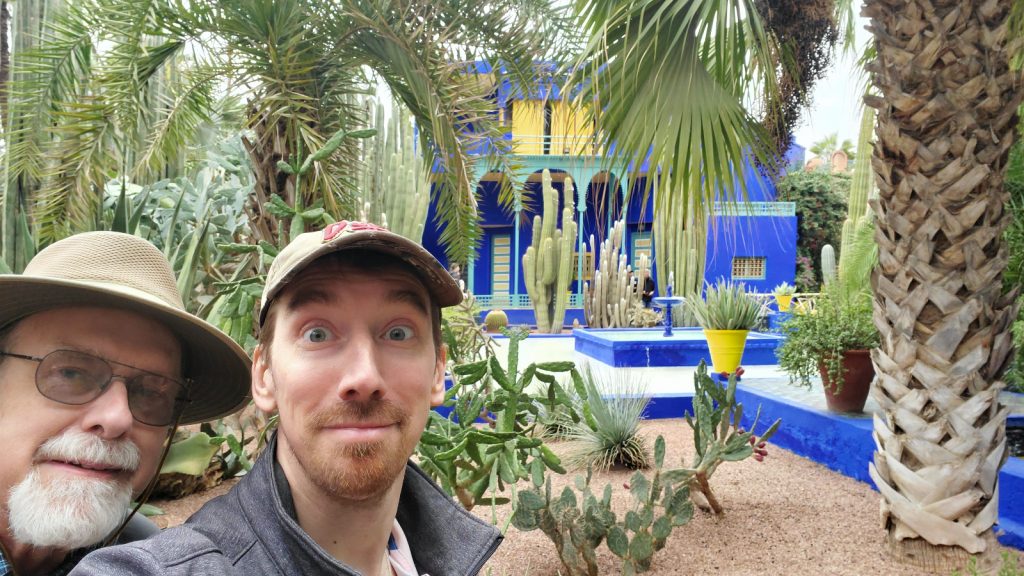
We had lunch at the Amal Women’s Training Center (Amal means hope in Arabic) – more details on them and their mission here. After the earthquake, my mom had heard that they were making food for the displaced families, rescue workers, etc – we were happy to support them. The food was great too.
After a brief return to Maison Arabe, the second part of the day began when our effervescent guide, a woman about my age named Ouidad arrived to take us to part of the old city. Cracking jokes about her family, particularly mother and mother in law seemed second nature to her – a midwesterner might describe her as “a real hoot.” She gushed about King Mohammad the Sixth, in power since 1999, for his reformist attitude toward women and his subsidizing of and expanding the idea of cooperatives to better support local artisans and creators of Moroccan handicrafts. In particular, she mentioned that he legally codified the possibly less popular (with men at least) lines of the Qur’an that state that in order for a man to marry up to four wives, the preceding and incoming wives all have to be equally cared for. Men are not allowed (legally, at least – no idea about religiously) to marry another woman unless his preceding wives all officially sign off and agree to him adding more wives to his harem. Ouidad chuckled at this and said that her own husband was allowed to marry a beautiful, younger woman who would cook for him, bear him more children, and the like… but he’d better like being asleep for the rest of his life because it’d only be “in his dreams!” She was wearing a long, flowing black djellaba, with a black and white checked keffiyeh (i.e. traditionally Palestinian, vs the traditionally red Bedouin/Jordanian one I typically wear) pinned to her left shoulder. I also noticed her fingernails were painted with the Palestinian flag. We didn’t talk politics (although she, like Rachid before her) also mentioned with great pride the millennia-long history of cooperation and tolerance between Abrahamic religion in the kingom) but I had a pretty good guess of her feelings on the current goings-on in Gaza.
We saw some small examples of the shockwaves of the earthquake damage as we approached the old city and its, well, old buildings. A collapsed wall here, cracks in masonry there. The walls closed in and the shadows rose. At this point I thought we’d finally be free of exhaust fumes and the belch of moped engines but alas, this is where I learned that even in this most ancient and claustrophobic part of the city, mopeds and their owners are like cats: they go where they please. It seemed absolutely baffling to me that this highly touristed city doesn’t try to reign in this dangerous, loud, smelly, and rude problem, somehow – mopeds only between 7pm and 7am perhaps, to allow business owners of the tiny shops to get merchandise in and out to the main streets where cars and trucks also roamed? Ouidad agreed that it was a big problem but she seemed resigned that nothing would change in that regard anytime soon. Come on, Mohammad – you’re the reformist, let’s see some more reforms for health and safety too!
The main attraction deep within the old city was the Maderssa Ben Youssef, a males-only school (obviously prior to His Majesty M. the 6th!) with absolutely breathtaking cedar wood and plaster/stone carvings all over the walls of its central courtyard. I’ve been quite a few mosques and madrasas over the years now, and the usage of carved wood in exteriors (vs ceilings which I see all the time) is, to my non-expert mind, fairly unique. Dark and weathered, it adds a certain secondary feel of nature to the ever-present ‘water feature’ that has been in every single riad courtyard we’ve been in so far in Morocco. Ouidad pointed out that boys and men of all ages studied here, and studied all things – science, chemistry, mathematics, medicine, and pondered the Qur’an and its meanings. The latter was perhaps one thing they didn’t need to study too much – like many madrasa of the time, every man was required to have the Qur’an memorized by heart – the instructors and school leaders would say to the prospective student in front of them, Read this Surah to me, and this verse, and if you could not read it exactly in the perfect, unchanging words of God… well, better luck next time, hope you didn’t have too far to travel to get here.
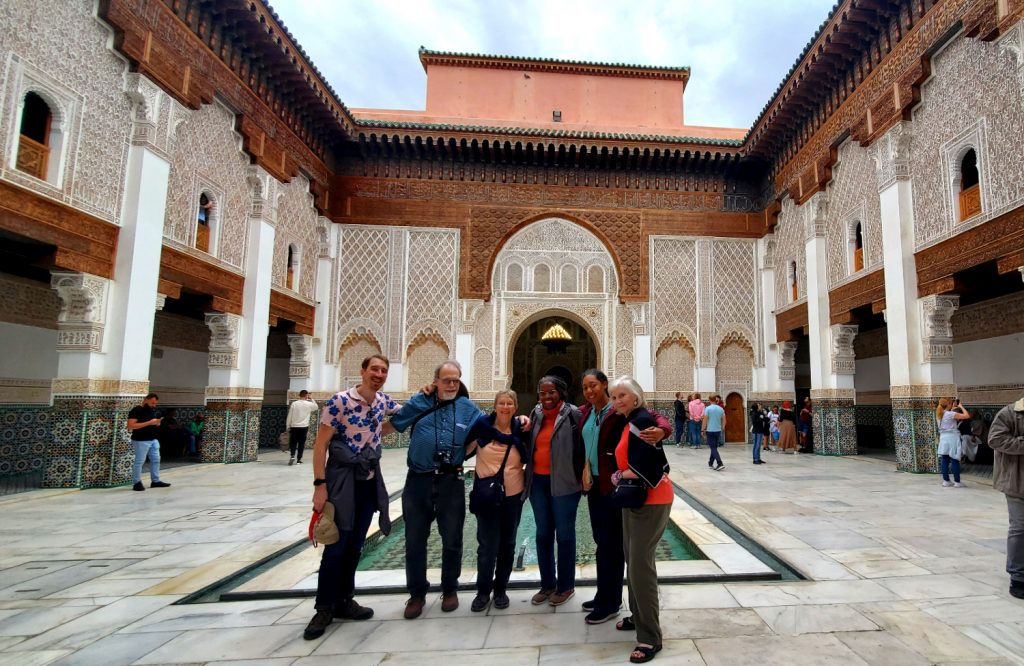
The rest of the building besides the courtyard was more or less a dormitory of 136 rooms ranging from “small” to “oh god you’re telling me they put 4-6 people in this, seriously”. According to records from the madrasa’s height, about 900 students stayed here together. But only something like 8-10 dormitory rooms had an exterior window at all – but at least it got to overlook the gorgeous courtyard from the second story. And of course, Ouidad continued, these rooms were highly sought after (please Allah, I need some fresh air, as this room is filled with four other sixteen year old boys) and they were only for the few dozen boys or men with the best grades. And at this point, you couldn’t just run your credit card at the Maison Arabe to upgrade to the deluxe suite.
Ouidad rounded out the tour by leading us back out of the old city via a different round – twisting, narrow corridors (slightly fewer mopeds as evening fell) with a shop, some no larger than a phone booth with a wizened man making belt buckles, some carved back 30 meters containing a man in a polo shirt, glasses, and a quarter million USD worth of rugs, lamps, mirrors, and other home furnishings. It reminded several of us of Istanbul’s Grand Bazaar, except with less regulation, organization, or vendors trying to hawk “turkish viagra.”
A couple last stops were made on our way out of the labrynthine souqs – a woman-owned Berber traditional medicine cooperative and a rug seller. The former was hosted by a similarly-aged friend of Ouidad’s, Waf’a, a dark-haired woman who like our guide had a knack for telling jokes, but in a much more deadpan and wry way – mostly somewhat dated “men, amirite ladies” material, but her practiced delivery still made it pretty amusing. She had an adorable three year old daughter, Yulia, who cavorted around us as we sat and drank “royal tea” and embraced her “auntie Ouidad” before snuggling up between Connie and Betsy to receive some stickers from the latter; she recognized immediately that older ladies would be prime targets for fond attention. Waf’a knew her male audience as well too, she was a bit of a salesflirt and “offered” her number to me slipped into a bag of tea if I might be interested in buying it. I showed her my wedding ring to laughter from the rest of the group and she sighed theatrically, rolled her eyes skyward and said Ah Zach, you’ve ruined everything for us. I bought the tea anyway, and some “Ras al Hanood” spice, one of the most common in the region (it means “head of the shop” as in, you can usually find it right at the front of every cook’s cupboard). As I was ringing up in another room, and everyone else was chatting back in the main hall, Waf’a poked her head around the corner, dropped a packet of something into my bag and winked. “For you and your wife,” she grinned. It was a package of “natural Berber aphrodiasic” and my dad told me afterward that he’d been given one as well. Meanwhile, the four ladies of our group had each been given a green chapstick. I think Waf’a made out pretty well – a saavy saleswoman, to be sure!
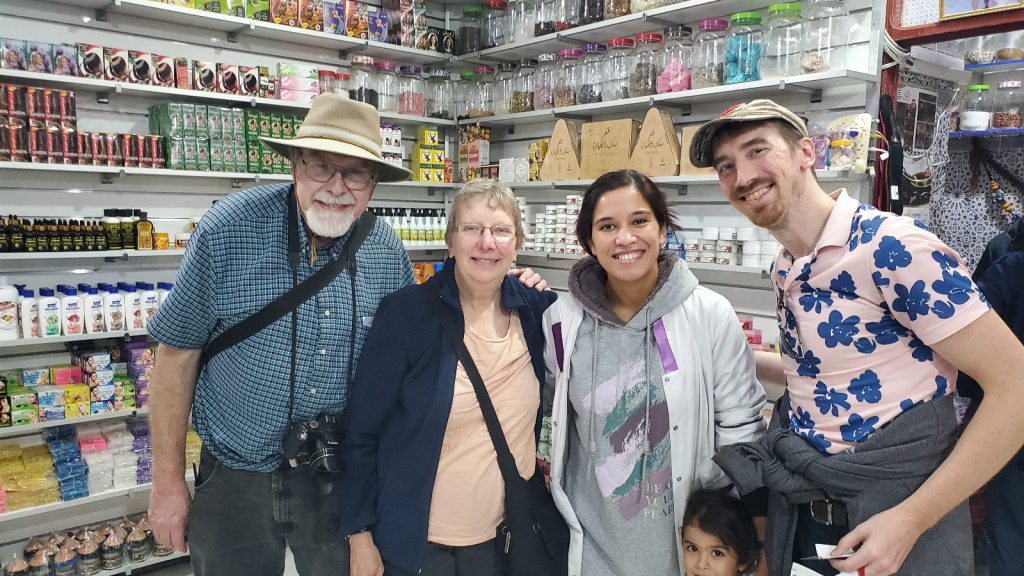
Ouidad, like Rachid in Essouraia before her, had managed to keep us out on her tour for three hours longer than we had expected – every one of us certainly felt that we had gotten our money’s worth, and maybe too much, taking into consideration soreness of leg and joints. We bid her goodnight after we finally stepped back onto streets that had motorized vehicles larger than motorcycles on them, and headed back to the hotel. The rest of the group were content with hotel snacks and drinks at the jazz bar, but I still had the energy to explore a bit.
On our walk back to the hotel just before, dad and I had smelled a strong, savory smell of meat being cooked somewhere a block from our lodgings. Following my nose, I sought it out again and found a man about my age scrolling through his phone in front of a large, savory smelling but empty grill. It turned out that the man, Hassan, was a Sausage Sandwich Salesman, and within a few minutes of popping open the top of his tupperware to reveal the savory sausages sequestered within and plopping about half of the remaining stock down on his now-sizzling grill, we were joined by another man. His name was Suror, and once again through a combination of them perfectly understanding my child-like vocabulary of Jordanian and them speaking very slowly and loudly, I learned that this was “al rajul lijeeb al-lahhmeh” – the man who brings the meat; his butcher. It was around 10pm by this time and Suror was done for the day, so he came by to eat the remainder of his friend’s stock – which got plopped on the grill as well. Hassan put the hot, spiced sausages (cow meat, he assured me) into a pita, handed me a bottle of hot sausage, and bid me a healthy appetite. He and Suror quizzed me on America and what I had been doing in the Middle East as the latter popped his sausages off the grill straight into his mouth. He and I agreed they were quite tasty, and a street food snack I’d never had in Jordan, Egypt, Palestine, or Egypt before.
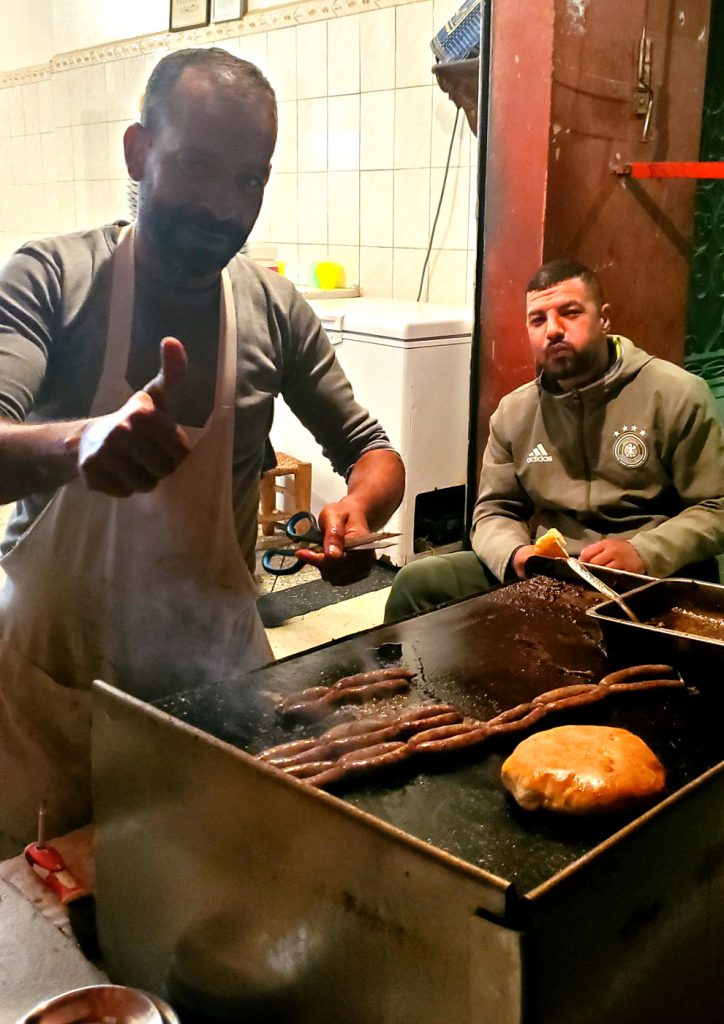
On our last day in Marrakech, my parents and I plus Betsy got another ride from Rachid the Small Berber to the old city again, this time to see a trio of ancient locations – starting with the Bahii Palace, of a similar time period as yesterday’s Madrasa (the same dynasty had built it, if I recall correctly) and in excellent shape (although not quite as beautiful as the wood-lined school). Who would we meet in the first 10 minutes, but Ouidad, leading a duo of woman around the palace? She exclaimed happily when I waved to her, and embraced my mother and aunt. From that point forward, as her new customers were wandering around apart from her and taking in the sights, she would seek us out and give us free nuggets of information about the palace, such as the fact the fireplaces were added in later during the French occupation and were not part of the original construction. Speaking of which, there was a particular plaque on the wall that mentioned that some of the stained glass in a certain window had been given by the French government in 1898 – this would have been only about a dozen years before France gave up pretenses of equanimity with the Moroccan sultanate and simply forced the country to become their protectorate under a puppet king. I found darkly amusing the idea of French ambassadors casually asking to measure the dimensions of the 300 year old windows of the Sultan’s palace. “It’s just for a gift, mon ami, we swear – by the way, which rooms get the best light in the evenings?”
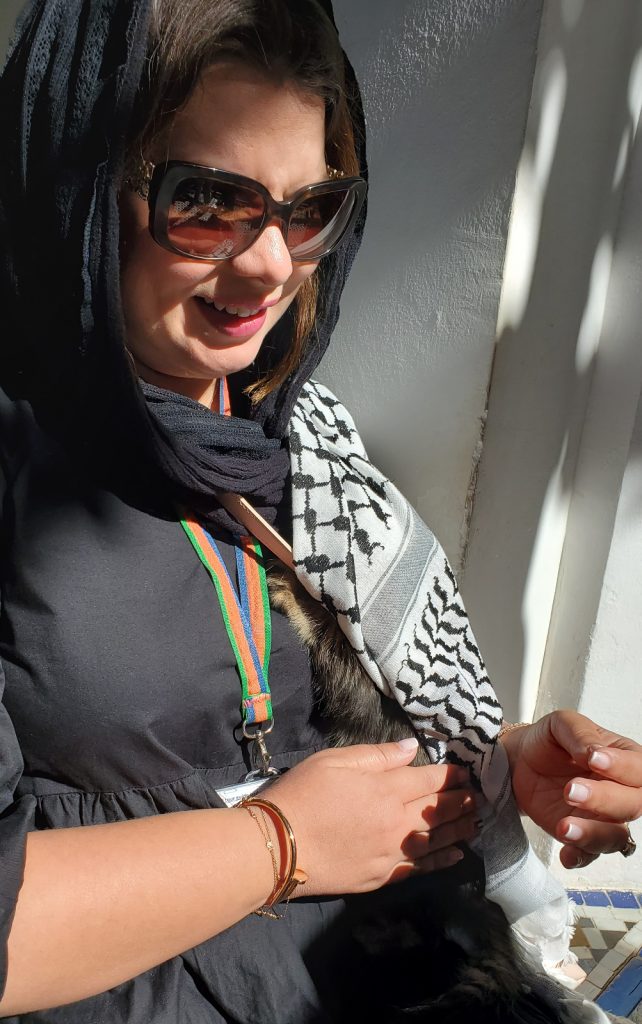
The second and third stops in the tour were both Sa’adeen, the dynasty predating the current Ala’ween one, and the second stop, Badi Palace, was definitely inching closer to being defined as a ‘ruin’ rather than an upkept museum like its newer sibling, the Bahii. Instead of small intricate rooms and passages like Bahii, Badi was primarily a large courtyard with four geometric sunken gardens that the earlier dynasty’s royalty would have enjoyed, including of course a water feature in the center that would have led to two now-destroyed columned rooms on either side (apparently after the fall of this dynasty, many of the most ornate mosaics, carvings, and the like had been carted off to add to new and existing palaces elsewhere). So, unfortunately, pretty much just the bare rose-red stone was all we could see here.

Lastly, the Sa’adeen tombs – thankfully, probably due to being filled with dead royalty and therefore restless spirits should they be disturbed, this small visit had more incredibly gorgeous and detailed stonework geometric carvings lining 2 of the 4-6 semi-covered alcoves that met around (of course) a courtyard. The floors of each of the alcoves, and also in seemingly random locations throughout the courtyard, were covered in mosaic-patterned rectangles – gravesites, a few with small “handles” on the tops of them, like butter keeper handles, inlaid with Arabic calligraphy that was, as it always has been for me, too complex and flowery for me to read more than an individual letter here or there. As lovely and peaceful as it was, particularly with several kitties snoozing comfortably upon the gravestones like they were the Prophet’s lap, it was a pretty small site, and we were in and out in under a half hour.
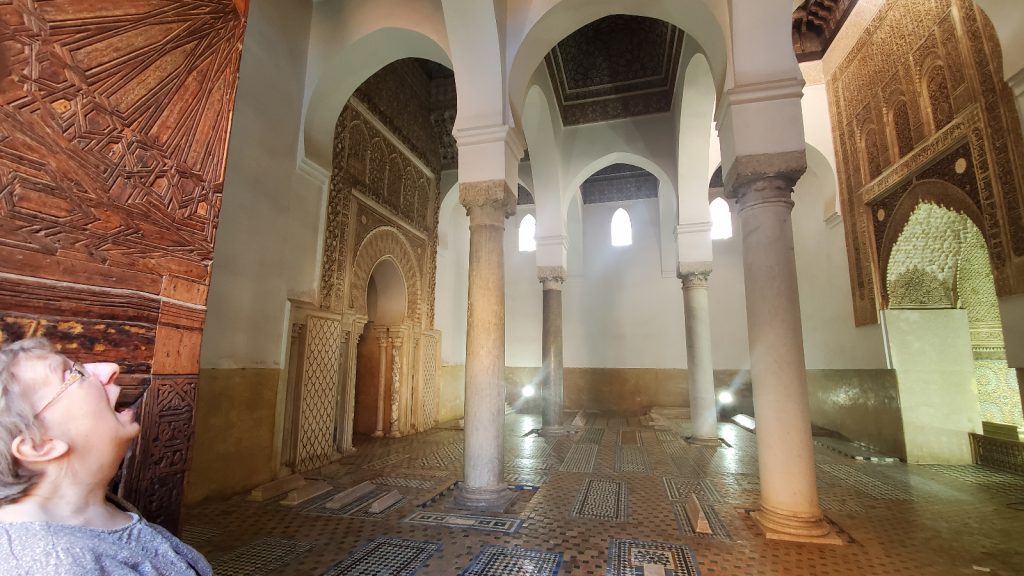
Legs getting tired once again, we meandered casually back toward the hotel, making sure to alter our route so that we’d be able to pass by the Kotoubia Mosque, a tall and imposing square stone tower jutting high above its surrounding buildings. I think (though am not positive, and currently without internet as of this moment as I write on the bus) that most, if not 100% of the mosques in Morocco are closed to non-Muslims, but due to the construction workers we saw swarming about the walls everywhere, and the lack of the faithful coming and going from any visibly open doors, that perhaps thanks to the earthquake, both the faithful and otherwise are prohibited from viewing the prayer hall from the inside. The minaret itself didn’t look damaged to me, but I’m not a structural engineer.
After a dinner together for the six of us at a Maison Arabe recommended place, Le Tanjia, which did indeed have an excellent candlelit ambiance, friendly staff, and of course, great food. My mom and I split a Tasting Menu of four types of tagine – the cone-shaped clay, or metal, or ceramic cooking vessel that is symbolic of Moroccan cooking and also the impetus for this post’s title. I pinged our driver friend Rachid’s whatsapp, and his white van appeared within 5 minutes to cart Betsy, Connie, and Nicole back to the hotel. My parents and I went along partway with the other three, but asked Rachid to drop us off at the Jemaa Fnaa square and we’d continue back on our own. We really didn’t know what to think exactly about this well known (both to tourists and locals) location, which depending on accounts contains snake charmers and trained monkeys, both experts at either directly or indirectly relieving tourists of their dirhams (a couple of our party had nope’d out entirely at that description) – or was just a big loud party of street food stands, teenagers, and pickpockets. Fnaa, after all, means “the backyard” and it seems that, like a backyard party with a thousand of your neighbors, anything really goes there. Rachid told the three of us brave explorers to tuck our phones and wallets deep inside our jackets.
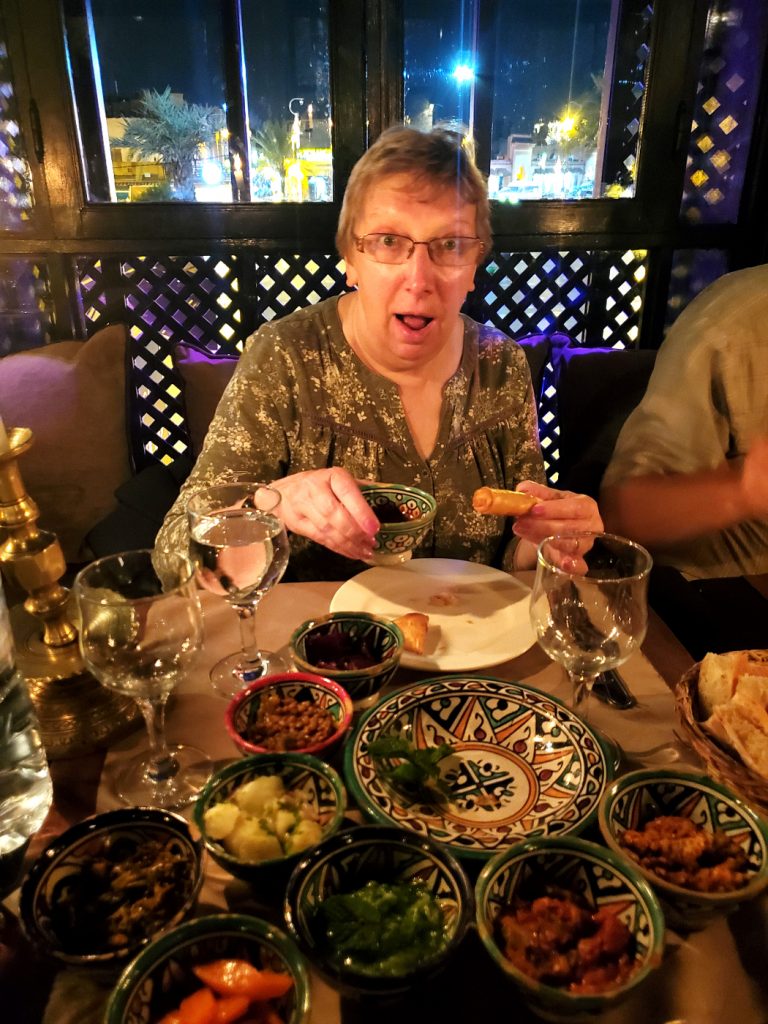
With only some trepidation, we headed down the gaudily lit, extremely packed pedestrian walkway (finally, a place without mopeds! I knew it had to exist somewhere!) toward the lights of the square, which we could see as hundreds of cold blue LED lights. I scanned the faces of the people around us – it seemed like not many European-ancestried tourists were to be found. I hoped this wouldn’t further increase our likelihood of becoming “marks.” But then as the walkway opened up into the large, loud, chaotic square… it seemed completely fine, to my Jordan-tuned sensibility at least. Shabob, young dudes in jackets with slicked hair, were hanging out with each other, laughing, dancing to boomboxes or makeshift drums, vendors selling trinkets who mostly seemed more interested in staring at their phones, but by far the most common were fruit smoothie sellers on tall food, who hawked and cajoled a little, and the tent-covered street food sales stalls, lined up even with numbers above each stall, dozens of them… each one seemed to have employed their own personal cajoler who would verbally pounce on us with big smiles as soon as we had shaken off the previous one. “Hungry, sirs? Please to eat at my restaurant? Just a snack, if you like!” etc. Some followed us for a few more stalls as I continued to try to, still politely, give them the brushoff with the excuse that we had literally just eaten a half hour ago. I avoided speaking Arabic here specifically to make myself as uninteresting a target as possible, and eventually we were able to work our way back to the musical section of the crowd, wallets unscathed. A successful walk, and nary a monkey or snake in sight.
And so ends our two-ish days in Marrakech! I feel satisfied with how much we were able to pack into it, between guided and self-guided tours. I was also happy I get to get some literal local flavor via Hassan’s street sausages, too, and not just dine at touristy restaurants that a Kechian of median income wouldn’t see. Now we’re all caught up, and I’m heading up into the Atlas. Let’s see what the southeastern part of the journey has in store.


No one has commented on this post - please leave me one, I love getting feedback!
Follow this post's comments, or leave a Trackback from your site